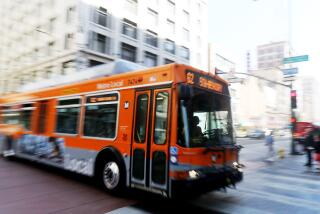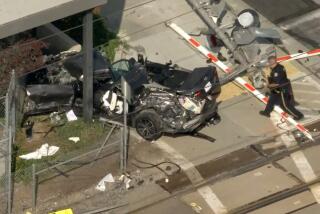Driver in Chicago train crash fired; minimum rest limits imposed
- Share via
Facing scrutiny after a rookie subway driver admitted to authorities that she fell asleep at the controls before a high-speed crash last month, the Chicago Transit Authority said this week that it will impose limits on how many hours drivers can work without rest.
The driver, whose name has not been officially released, was fired Friday for two significant safety violations, the agency told reporters. She was operating a Blue Line train at about 2:50 a.m. March 24 when it surged into the station at O’Hare International Airport, struck a barrier and derailed onto the passenger platform.
Video footage shows the eight-car train surging up an escalator and coming to a halt near the top.
More than 30 people were injured, some of whom have sued the agency for negligence. Damage to the train alone was pegged at $6 million.
NTSB investigators have yet to say what caused the crash and why the braking system, including the automatic emergency brake, didn’t do more to slow and stop the train.
The driver, who had been on the job about two months, had a constantly changing schedule and had most recently worked the night before the accident, the NTSB said. She told investigators that she had dozed off while operating a train the previous month. Between that violation and the O’Hare crash, the CTA said it had enough grounds to fire her.
The “stringent” scheduling changes announced Friday limit rookie drivers to 32 hours of operating a train per week, the agency said. They’ll be assigned to other duties during other work hours. There had been no limit before.
“Any time an incident like this occurs, we take very seriously the responsibility of thoroughly reviewing all aspects of what happened -- including longstanding policies and practices,” CTA President Forrest Claypool said in a statement. “In this instance, there were changes we could make that are appropriate and that further maximize safety for our customers and for our employees.”
The other changes would limit train operators to 12 hours of driving in a 14-hour time frame, increase the minimum rest time between shifts to 10 hours from eight hours and require drivers to take at least one day off during every seven-day period.
The accident shut down the station for about a week. Once it reopened, the approach speed limit was reduced to 15 mph from 25 mph and automatic speed-reduction arms were moved further away from the station entrance.
Follow LATimes National on Facebook
ALSO:
Judge to grant same-sex couples more recognition in Ohio
Family, friends recall lives of 3 killed in Ft. Hood shooting
Welder’s sparks caused Boston fire that killed 2 firefighters
More to Read
Sign up for Essential California
The most important California stories and recommendations in your inbox every morning.
You may occasionally receive promotional content from the Los Angeles Times.











